The Science Behind Laundry: How Detergents and Water Temperature Affect Your Clothes
Post Date:

Laundry is a routine chore for most of us, yet many don't fully understand the science behind it. There's a world of chemistry that works to keep our clothes clean, and the choice of detergent and water temperature can significantly impact the outcome. Understanding these factors can help improve your laundry results and extend the life of your clothing. In this blog post, we will explore the role of detergents and water temperature in laundry, providing you with a better understanding of how to keep your clothes fresh, clean, and vibrant.
We'll begin by diving into the makeup of laundry detergents, understanding their purpose, how they interact with different fabrics, and their environmental impact. We'll then explore the importance of water temperature in the washing process, including the effects of different temperatures on fabrics and stains, as well as energy considerations. The goal is to equip you with the knowledge you need to make informed decisions about your laundry routine, benefiting both your clothes and the environment.
Understanding Laundry Detergents
Laundry detergents are a crucial part of the cleaning process. But what exactly are they made of, and how do they work? The primary component of laundry detergents is a class of compounds called surfactants. These surfactants are responsible for the 'cleaning power' of detergents. They have a unique molecular structure, with one end that's attracted to water and another that's attracted to dirt and oil. When you wash your clothes, the surfactants surround and lift away the dirt and oils from the fabric, suspending them in the water to be rinsed away.
However, not all detergents are created equal. Some detergents contain enzymes to help break down proteins, starches, and fats in stains, making them easier to remove. There are also specialized detergents designed for different fabrics and colors. For instance, some detergents are gentler, making them suitable for delicate fabrics, while others are formulated to help keep bright colors from fading. Unfortunately, conventional detergents can have a negative environmental impact. They may contain phosphates, which can cause water pollution, and synthetic fragrances, which can contribute to air pollution.
The Role of Water Temperature in Laundry
Water temperature plays a vital role in how effectively your clothes are cleaned. Hot water has long been associated with better cleaning because heat helps to activate the detergent, making it more effective at breaking down stains. Hot water also helps to sanitize clothes, making it a good option for heavily soiled items, or those that need disinfecting, like towels and bed sheets. However, hot water can cause some fabrics to shrink, colors to fade, and delicate items to become damaged.
On the other hand, cold water is gentler on clothes, reducing the chances of shrinking and color fading. Modern detergents are also designed to perform well in colder water, making it a more viable option for everyday laundry. Additionally, washing in cold water is more energy-efficient, as a significant amount of energy used in washing clothes goes to heating the water. However, cold water may not be as effective at removing certain types of stains, such as oil-based stains.
Understanding the role of water temperature in the washing process can help you make better choices based on your laundry needs. For instance, using hot water for heavily soiled items and cold water for regular, less dirty clothes can help balance the need for effective cleaning, fabric care, and energy conservation.
Choosing the Right Detergent and Water Temperature for Your Clothes
Selecting the right laundry detergent requires considering several factors. The type of fabric you're washing is perhaps one of the most important. Delicate fabrics such as silk or wool often need a gentler detergent, while sturdier fabrics like cotton or denim can handle stronger detergents. It's essential to read the care labels on your clothes, as these often provide crucial information about the type of detergent that's safe to use.
Another important factor to consider is the color and pattern of your clothes. Colored clothes can fade over time, particularly if a harsh detergent is used. Detergents formulated for colored clothes can help maintain the vibrancy of your clothes for longer. Similarly, dark clothes can develop a faded, "washed out" appearance with harsh detergents, so a detergent specifically designed for dark clothes could be a wise choice.
The level and type of dirt or stains on your clothes should also influence your choice of detergent. Heavily soiled clothes or clothes with tough stains like grass, wine, or blood can benefit from a detergent with enzymes designed to break down these specific stain types. For lightly soiled clothes or clothes with oil-based stains, a regular detergent should suffice. Again, it's essential to read and follow the instructions on the detergent package to get the best results.
Choosing the appropriate water temperature also involves several considerations. As a general rule, hot water is ideal for whites and heavily soiled items, while cold water is better for colored clothes and lightly soiled items. It's important to remember, though, that "hot" doesn't mean "boiling." Very hot water can damage certain fabrics and cause colors to fade. Instead, a warm setting is usually sufficient for most laundry tasks. Additionally, many washing machines now come with a "warm" setting, which mixes hot and cold water, providing a good middle-ground for mixed loads.
Energy efficiency is another factor to consider when deciding on water temperature. Washing clothes in cold water uses less energy, which can lead to significant savings on your energy bills over time. Moreover, washing in cold water reduces your carbon footprint, contributing to environmental conservation efforts. While there are times when using hot water may be necessary, choosing cold water whenever possible is a good habit to adopt for energy conservation and sustainability.
Understanding the science of laundry can transform the way we approach this routine task. Choosing the right detergent and water temperature is not just a matter of habit, but a decision that affects the cleanliness and longevity of our clothes, as well as the environment. With the insights provided in this blog post, you are now better equipped to make informed choices when it comes to your laundry. It is our hope that these insights will help you get the most out of your washing while preserving the quality of your clothing and reducing environmental impact.
We've gone over the components of laundry detergents, discovered how they work to remove dirt and stains, and explored the impact of water temperature on the washing process. We've also considered important factors in selecting the most suitable detergent and water temperature for our laundry needs. By understanding these elements and how they work together, we can improve our laundry practices and achieve better results.
Laundry is more than just a chore. It's a science that, when understood, can enhance the effectiveness of our washing, care for our clothes, and even contribute to energy conservation. So, the next time you load your washing machine, remember the science that goes into cleaning your clothes. With this knowledge, you'll not only have cleaner, fresher clothes but also a greener planet.
Last Update: Jun 24, 2023 / 12:00 AM
Related Posts
Expert Cleaners
Let proffesionals clean your clothing
Detailed Inspection
Pockets, stains, clothing labels
Cleaning Rewards
Earn rewards on every order
Pick-up & Delivery
Fast pick-up and delivery to your home


